MNIST Digit Classifier in TensorFlow
I’m currently progressing through the Advanced Learning Algorithms course by Andrew Ng. To get some hands-on practice, I decided to work on the classic MNIST dataset, which contains 60,000 28×28 grayscale images of handwritten digits (0 to 9). The dataset can be downloaded directly from the MNIST homepage.
Jupyter Notebook
To get started, I used a Jupyter Notebook running TensorFlow, installed via my Kubeflow on K8s.

Load Data
TensorFlow provides a convenient way to load the MNIST dataset.
import tensorflow as tf
from tensorflow import keras
(X_train, y_train), (X_test, y_test) = keras.datasets.mnist.load_data()
assert X_train.shape == (60000, 28, 28)
assert X_test.shape == (10000, 28, 28)
assert y_train.shape == (60000,)
assert y_test.shape == (10000,)
Visualise the Data
To better understand the dataset, I visualized a random sample of 64 digits from the training set:
import numpy as np
import matplotlib.pyplot as plt
import warnings
warnings.simplefilter(action='ignore', category=FutureWarning)
m = X_train.shape[0]
fig, axes = plt.subplots(8, 8, figsize=(5, 5))
fig.tight_layout(pad=0.13, rect=[0, 0.03, 1, 0.91])
for i, ax in enumerate(axes.flat):
random_index = np.random.randint(m)
image_to_display = X_train[random_index].reshape((28, 28))
ax.imshow(image_to_display, cmap='gray')
ax.set_title(y_train[random_index])
ax.set_axis_off()
fig.suptitle("Label, Image", fontsize=14)
plt.show()
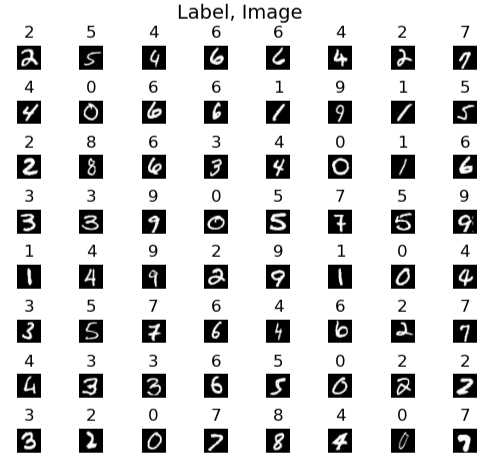
Model Representation
Each image is a 28×28 pixel grid, which we “unroll” into a 784-dimensional input vector. The architecture of our neural network is:
- Input layer: 784 units
- Hidden layer 1: 128 units (ReLU)
- Hidden layer 2: 64 units (ReLU)
- Output layer: 10 units (for digits 0–9)
We start by normalizing pixel values from 0–255 to 0–1 and flattening the image data:
from tensorflow.keras.models import Sequential
from tensorflow.keras.layers import Dense
from tensorflow.keras.activations import linear, relu
X_train = X_train.astype('float32') / 255.0
X_test = X_test.astype('float32') / 255.0
X_train = X_train.reshape(X_train.shape[0], -1)
X_test = X_test.reshape(X_test.shape[0], -1)
tf.random.set_seed(1234)
model = Sequential([
Dense(128, activation='relu', input_shape=(784,)),
Dense(64, activation='relu'),
Dense(10, activation='linear')
], name = "my_model")
model.compile(
loss=tf.keras.losses.SparseCategoricalCrossentropy(from_logits=True),
optimizer=tf.keras.optimizers.Adam(0.001),
metrics=['accuracy']
)
model.summary()
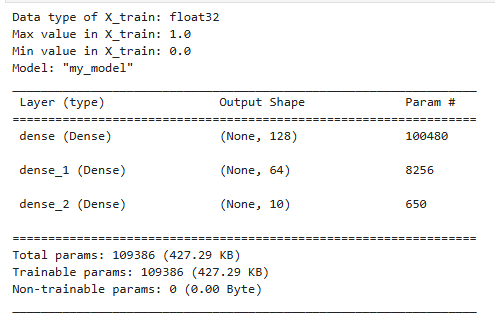
Train the Model
print("Starting model training...")
history = model.fit(
X_train,
y_train,
epochs=60
)
print("Model training finished.")

Evaluate the Model
print("\nEvaluating model on test data...")
loss, accuracy = model.evaluate(X_test, y_test, verbose=0)
print(f"Test Loss: {loss:.4f}")
print(f"Test Accuracy: {accuracy:.4f}")
# Sample output
Evaluating model on test data...
Test Loss: 0.1928
Test Accuracy: 0.9815
Loss (Cost) Plot
def plot_loss_tf(history):
try:
fig, ax = plt.subplots(figsize=(8, 5))
ax.plot(history.history['loss'], label='loss', color='deepskyblue', linewidth=4)
ax.set_title('Model Loss During Training')
ax.set_ylabel('Loss')
ax.set_xlabel('Epoch')
ax.legend(loc='upper right')
ax.grid(True, color='lightgrey', linestyle='-')
plt.tight_layout()
plt.show()
except Exception as e:
print(f"Error plotting: {e}")
plot_loss_tf(history)
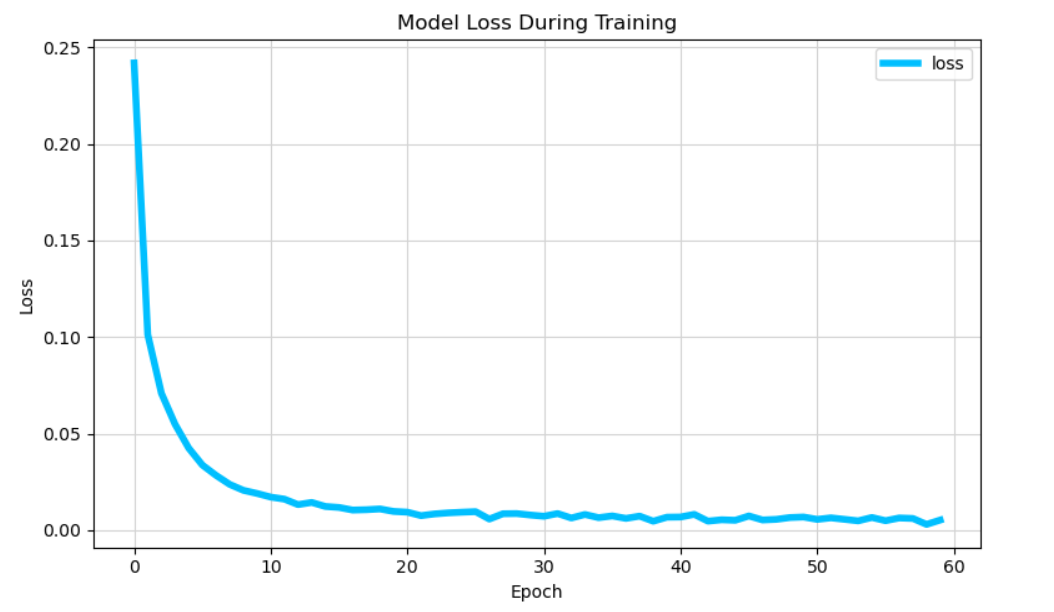
Model Prediction
Let’s try predicting a digit:
import numpy as np
def display_digit(image_vector):
try:
image_matrix = image_vector.reshape((28, 28))
except ValueError as e:
print(f"Error reshaping vector of size {num_pixels} to {dimension}x{dimension}: {e}")
return
plt.imshow(image_matrix, cmap='gray')
plt.axis('off')
plt.show()
image_of_three = X_train[8888]
display_digit(image_of_three)
print(y_train[8888])
prediction = model.predict(image_of_three.reshape(1,784))
print(f"Prediction logits:\n{prediction}")
print(f"Predicted digit: {np.argmax(prediction)}")
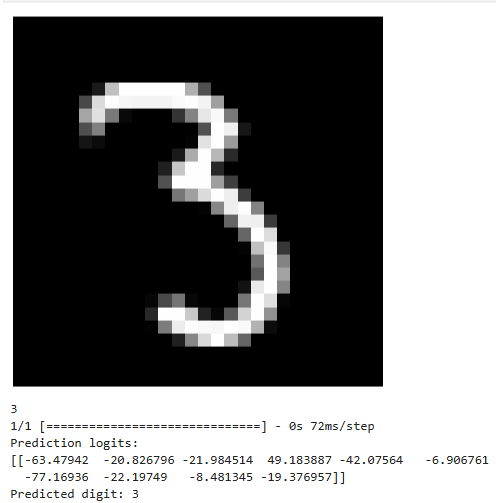
Convert Logits to Probabilities
prediction_p = tf.nn.softmax(prediction)
print(f"Probability vector:\n{prediction_p}")
print(f"Sum of probabilities: {np.sum(prediction_p):.3f}")
# Sample output
Probability vector:
Probability vector:
[[1.1407684e-31 3.7281105e-25 1.1554550e-28 1.0000000e+00 4.0587488e-31
4.0818696e-23 0.0000000e+00 1.4413385e-26 1.2729607e-21 7.6773376e-23]]
Sum of probabilities: 1.000
Index of the largest probability for predicted target
yhat = np.argmax(prediction_p)
print(f"np.argmax(prediction_p): {yhat}")
# Sample output
np.argmax(prediction_p): 3
Prediction on Sample Set
fig, axes = plt.subplots(8,8, figsize=(5,5))
fig.tight_layout(pad=0.13,rect=[0, 0.03, 1, 0.91])
for i,ax in enumerate(axes.flat):
random_index = np.random.randint(m)
image = X_train[random_index].reshape((28,28))
prediction = model.predict(X_train[random_index].reshape(1,-1), verbose=0)
yhat = np.argmax(tf.nn.softmax(prediction))
ax.imshow(image, cmap='gray')
ax.set_title(f"{y_train[random_index]},{yhat}", fontsize=10)
ax.set_axis_off()
fig.suptitle("Label, Predicted", fontsize=14)
plt.show()
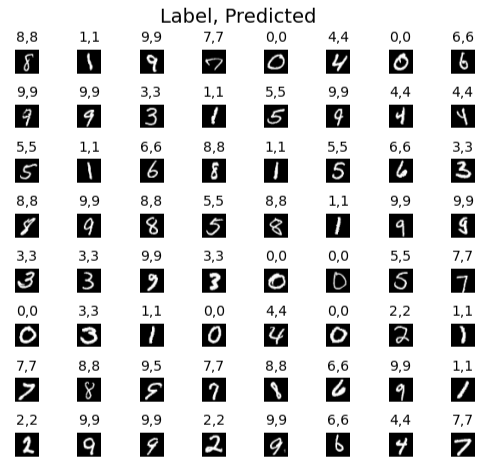
Final Evaluation on Test Set
from sklearn.metrics import classification_report, confusion_matrix
print("\nMaking predictions on the test set...")
test_logits = model.predict(X_test, verbose=1)
print("Shape of raw predictions (logits):", test_logits.shape)
test_probabilities = tf.nn.softmax(test_logits).numpy()
y_hat = np.argmax(test_probabilities, axis=1)
print("\nClassification Report:\n")
print(classification_report(y_test, y_hat))
print("\nConfusion Matrix:")
cm = confusion_matrix(y_test, y_hat)
print(cm)
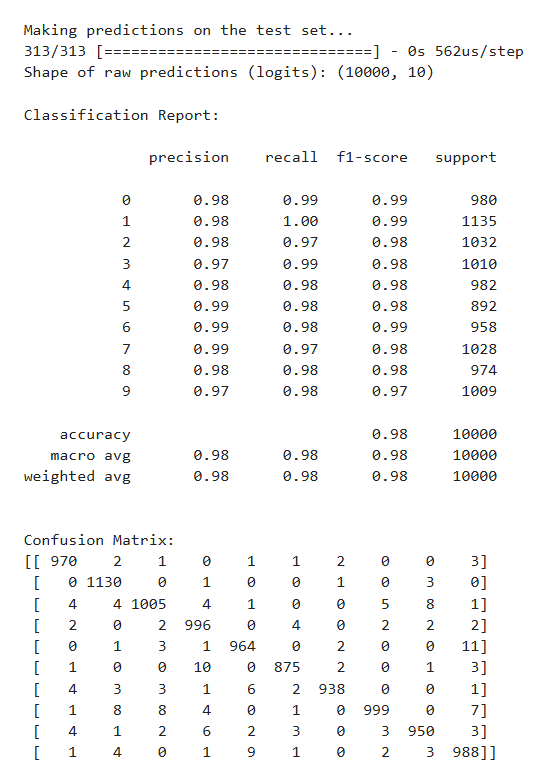
Inspect Prediction Error
error_mask = (y_hat != y_test)
error_indices = np.where(error_mask)[0]
print(f"Number of errors found: {len(error_indices)} out of {len(y_test)} test samples.")
print(f"Model accuracy on test set: {1 - (len(error_indices) / len(y_test)):.4f}")
num_errors_to_show = 16
if len(error_indices) == 0:
print("No errors found! Model is perfect on the test set.")
elif len(error_indices) < num_errors_to_show:
print(f"Warning: Found only {len(error_indices)} errors, displaying all of them.")
selected_error_indices = error_indices
num_errors_to_show = len(error_indices)
else:
selected_error_indices = np.random.choice(error_indices, num_errors_to_show, replace=False)
if num_errors_to_show > 0:
grid_size = int(np.ceil(np.sqrt(num_errors_to_show)))
fig, axes = plt.subplots(grid_size, grid_size, figsize=(6, 6))
fig.suptitle(f'Sample Misclassified Images (True vs Predicted)', fontsize=16)
axes_flat = axes.flatten()
for i, error_idx in enumerate(selected_error_indices):
ax = axes_flat[i]
image_vector = X_test[error_idx]
image_to_display = image_vector.reshape((28, 28))
true_label = y_test[error_idx]
predicted_label = y_hat[error_idx]
ax.imshow(image_to_display, cmap='gray')
ax.set_title(f"True: {true_label}\nPred: {predicted_label}", fontsize=10)
ax.set_axis_off()
for j in range(i + 1, len(axes_flat)):
axes_flat[j].set_visible(False)
plt.tight_layout(rect=[0, 0.03, 1, 0.95])
plt.show()
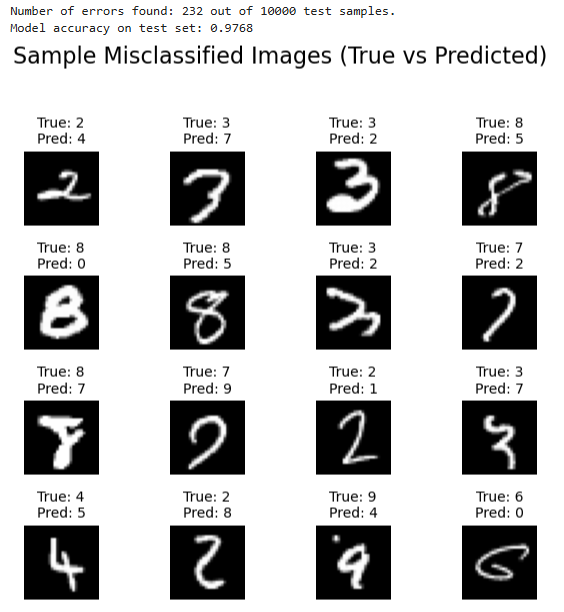
Conclusion
This was a great hands-on experience to reinforce the theory from Andrew Ng’s course. The model achieved over 97% accuracy on the test set using a simple feedforward neural network. Moving forward, I’m keen to explore more varied model architectures to further improve performance.